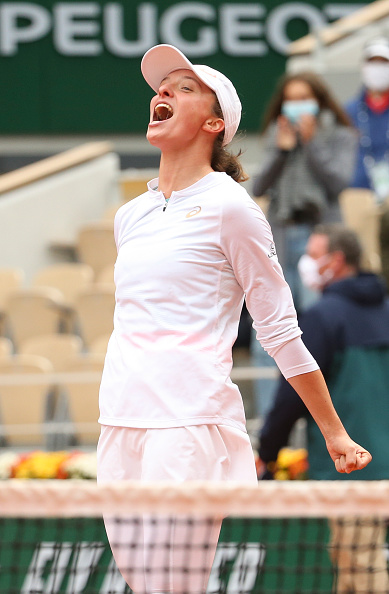Bill Simons
It’s election season, so naturally many folks out there are checking out a poll or two. But today, in a stunned tennis world, all eyes were on a very different Pole, an intriguing 19-year-old from Warsaw who gave us a where-did-that-come-from flash run, a shock performance that no one saw coming.
After Iga Swiatek had drubbed the supposedly fierce and always feisty American Sonya Kenin, court announcer Marion Bartoli gushed, “What an incredible, amazing, fabulous, emotional moment.”
No kidding. A fresh, happy force, Swiatek melds an almost serene, beyond-her-years calm with a deceptively easy power. Iga’s ranking is No. 54, she hadn’t won a tourney in two years and just weeks ago she exited in the first round of the Italian Open.
In the first round at Poland Garros, whoops, we mean Roland Garros, she dismissed last year’s finalist Marketa Vondrousova. Few noticed. But finally, when she crushed No. 1 seed Simona Halep 6-1, 6-2 in the fourth round, commentators and fans began wondering how the heck to pronounce her name. Nervous broadcasters shared notes and online videos provided some handy phonetics. The New York Times kindly told us to try “Shree-ON-tek.”
While proper Polish pronunciations can be elusive, it’s almost as challenging to come up with memorable Polish tennis achievements. Just three months before Germany invaded Poland in 1939, the long forgotten Jadwiga Jedrzejowska reached the French finals. Until today, no Pole had done it since.
Poland did give us a fine journeyman, Wojtek Fibak. Ivan Lendl’s close friend was a sophisticated fellow who collected more fine art masterpieces than titles. Two recent players of Polish heritage, German Angie Kerber and Dane Caroline Wozniacki, have lifted four Slam trophies. The now retired Pole, Agna Radwanska, delighted us with her flicks and pirouettes. Martina Navratilova claimed Radwanska was the “the most imaginative and creative player of her generation.” But, Martina added, “She was so risk-averse that she had a really hard time trying anything new…[She] was not one to venture out of her comfort zone.”
Does Iga Swiatek even have a comfort zone? She fearlessly tries new things. She meditates and visualizes. She’s powerful, athletic and imposing. She goes on court listening to a raunchy little Guns ‘N Roses tune, “Welcome to the Jungle,” that tells us, “You learn to live like an animal in the jungle where we play. If you got a hunger for what you see, you’ll take it eventually.”
Unafraid, Iga promotes the role of psychology. Goran Ivanisevic once said he doesn’t work with sports psychologists because, “You lie on a couch, they take your money and you walk out more bananas than ever,” but Swiatek has a different take. Like Arthur Ashe, she meditates on changeovers. Goodness, she actually goes on vacation with her therapist, Daria Abramowicz, and for two years has traveled the circuit with her. Abramowicz says performance is all about managing stress. She counseled Swiatek to treat Slam semis and finals as if they were just another first-round encounter on a back court.
In Paris, Swiatek played in an appealing multi-layered, all-white outfit with a long-sleeved top, a mini-skirt, demi-leggings and lots of flowing nuance. Abramowicz describes her as a normal kid who just graduated from high school, a teen who’s into music but is ambitious. At Roland Garros, Iga teased the sparse crowd, urging them to “Cheer for me, make it louder.” Her smile beams bright. Time and again she sputters joyfully in disbelief. Her go-to phrase is, “This is crazy.”
She couldn’t be more different from her foe. The tightly wound, Russian-born, Australian Open champ Sofia Kenin has a look – a linebacker look – in her eyes. She’s fierce. Her fight has been compared with Rafa’s. When frustrated, she’ll spike the ball into the court or fling a towel. She walks about the court with a battle march that would please any Marine drill sergeant worth his bark. “Her stomp just got a little stompier,” an analyst recently joked. Sonya describes herself in one word: “Feisty.” And just the other day, she told me the one thing she loves most about tennis: “Winning. Definitely.”
Mary Carillo compared the finalists: “If Sofia Kenin plays with feist, Iga Swiatek plays with jaunt. There’s something very jaunty about this teen. She’s powerful, she’s dynamic, she’s got energy.”
In the past seven years, we’ve seen seven different French Open winners: Swiatek, Ash Barty, Halep, Jelena Ostapenko, Garbine Muguruza, Serena and Sharapova. So Swiatek’s breakout story is not unique. In fact, in the wide-open world of women’s tennis, 9 of the last 14 Slams have been won by newcomers. Yet the seamless efficiency and dominance of Swiatek – who also reached the doubles semis – was simply astounding.
Yes, going into the final, the average ranking of her foes was just 90. The Pole hadn’t won any tour-level tourneys and had never reached a Grand Slam quarterfinal. She was the second lowest-ranked player to reach the final since 1977. But, amazingly, she didn’t drop a single set going into the final, and no one got more than four games off of her in a set. She’d broken her foe’s serves as if they were twigs.
After she swiftly crushed Argentinian qualifier Nadia Podoroska in the semis, Radio Roland Garros enthused, “For just over an hour, Iga looked like a superwoman. She was calm, her tennis was glorious, her face was full of joy and disbelief. What a stunning campaign.”
But surely, the Pole would waver under the pulsating pressure of playing her first Slam final. So many have. But, no, right out of the starting gate, Iga used her speed, her deep, heavy forehand, her flick volleys and her court positioning to impose herself on a stunned opponent. Sonya was continually scampering. On her back foot and out of sorts, she nevergot into her rhythm.
Swiatek rushed to a 3-0 lead. Kenin broke back to even matters at 3-3. The match seemed to have pivoted. Surely Kenin would now unleash one of her lethal counterattacks that Garbine Muguruza and Petra Kvitova know far too well.

But the Pole stood erect. In the pivotal eighth game, Swiatek literally took the racket out of Kenin’s hand. Calling on her spinny forehand and down-the-line backhand, she broke, in a marathon game.
The quiet, implausible rout was on. Iga would win seven of the next nine games. Analysts noted that her game has few weaknesses and she could be a force in the future.
But there were issues. After her win, it took her forever to navigate a maze of walls and gates to get to her thrilled family. Understandably, she was overwhelmed during the presentation ceremony and her answers drifted as she was flooded with emotion. And she told IT that she’d put into practice just 30 percent of what her therapist had told her to do.
Afterwards, the magician who’d morphed Roland Garros into Poland Garros confided, “It’s just overwhelming, it’s crazy…I don’t know what’s going on.” Neither did Sonya – neither do we, except that we can imagine that the teen who is into visualization might just become a champion for the ages.
In the coming weeks Americans will be offering their votes at the polls. Today, all of tennis offered their congratulations to a Pole who swept to victory in a landslide.
![]()



















